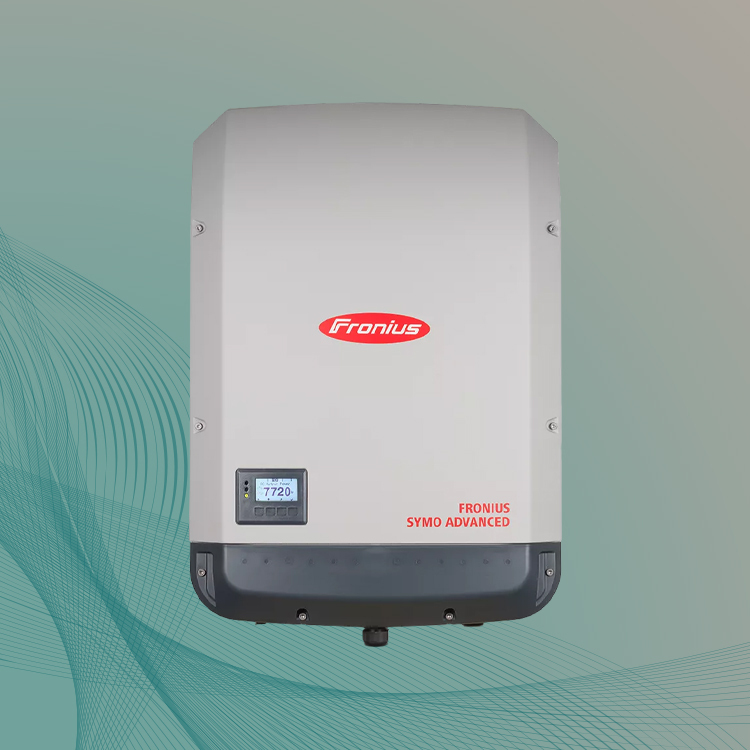


.webp)
.webp)
Application
The Fronius Symo Advanced 10.0-3-M is well suited for large homes, small businesses and small to large commercial PV systems without battery storage. Thanks to its robust design and active cooling it can be mounted outside without any risk of damage to the inverter or degraded performance in hot weather.
Features
SuperFlex design
The Symo Advanced 10.0-3-M features two independent MPP trackers with a wide input voltage range (200-1000 VDC).
As a result, the inverter supports unequal-length strings, enabling users to place panels on complex rooftops, which don’t allow an equal distribution of panels.
Furthermore, the Symo Advanced 10.0-3-M supports high input currents, making it compatible with the latest generation of PV panels.
Integrated data communication
Fronius was the first inverter manufacturer to offer a comprehensive suite of communication features in its inverters as standard.
The Symo Advanced 10.0-3-M has data logging, WLAN, Ethernet, energy management, a web server and all the necessary interfaces to connect to third-party devices. The inverter can connect to the Internet via an Ethernet cable or a Wi-Fi network.
Connection to third-party components is provided by means of interfaces such as Modbus TCP SunSpec, Modbus RTU SunSpec or the Fronius Solar API (JSON).
Dynamic Peak Manager
Fronius has developed its own advanced MPP tracking algorithm called Dynamic Peak Manager. The algorithm dynamically adapts its behaviour when searching for the optimal maximum power point.
By scanning the entire curve, Dynamic Peak Manager can reliably and quickly find the global maximum power point (GMPP), regardless of the constantly changing lighting conditions caused by clouds or partial shading.
Active Cooling
The Symo Advanced 10.0-3-M utilises an active cooling fan, which aids air circulation inside the inverter.
Active cooling maintains the power electronics at optimal temperature and prevents heat spots and overheating.
The result is prolonged service life, optimised yields and reduced costs.
SnapINverter technology
The connection area and power stage of the Symo Advanced 10.0-3-M are separate modules.
Fronius calls its modular inverter design SnapINverter.
Inverters equipped with this feature address a lot of the challenges installers and operators of large PV systems with many inverters face.
This clever design allows installers to mount the lightweight connection area first. The connection area even features provisions for DC overvoltage protections in the inverter itself.
The power stage then simply attaches to the connection area.

This design significantly simplifies maintenance and reduces downtime in the unlikely event of a failure, which is especially desirable for large commercial PV systems.
Fronius Arc Guard technology
Arc Guard is Fronius’ software-based built-in AFCI (Arc Fault Circuit Interrupter) protection.
The technology relies on a sophisticated software algorithm to continuously monitor for and reliably detect arc faults and shut down the PV system to protect it from damage.
Arc faults can occur when the insulation or MC4 connectors of the solar cable have been damaged or improperly plugged in.
An exposed cable can allow an arc to jump from the cable to another conductor, causing damage or potentially starting a fire.
Fronius is actively developing Arc Guard, further improving the algorithm and making it faster and more reliable.
When a compatible energy meter is connected, the Symo Advanced 10.0-3-M allows users to set a grid feed-in limit, including the option for zero feed-in.
The inverter prioritises supplying power to the user and dynamically adjusts its output to the grid, staying within the defined feed-in parameters.
For more information, please refer to the technical documentation and manuals provided by the manufacturer, which can be found on this webpage.

Building Services Plovdiv is an official Fronius sales partner.
Inverters are electrical devices that convert DC electricity to AC which is suitable for powering regular household appliances. There are different types of inverters, each with its pros and cons. Among the common inverter types used in photovoltaic systems are grid-tie inverters, microinverters and hybrid inverters. ...
Remarks, reviews & ratings